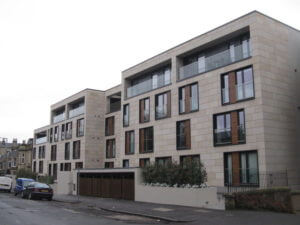Class A – New flats on detached blocks of flats

Class A was introduced in an update to the GPDO on June 25th 2020 and took effect from 1st August 2020. It allows for the construction of up to two additional floors on a purpose built detached block of flats. I.e the upwards extension of two storeys of residential flats on a current block within the airspace.
The flats must have been constructed between 1st July 1948 and 5th March 2018. This is not available on conversions created under the GPDO Part 3 in Class M, Class N, Class O, Class P, Class PA or Class Q. In other words not a conversion unless full planning has been obtained and the works completed before 5th March 2018.
Importantly the new dwellings must be C3 flats only. They cannot be converted to HMOs using Class L. If you wish to move to an HMO full planning would be required.
See our useful table of all airspace opportunities available within the GPDO.
What else might prevent me taking advantage?
The current block must be detached and so not connected to one or more other buildings, even if these are flats. The current building must be at least three storeys high and by adding the new storeys you do not exceed 30 metres in height. Although plant and machinery may be higher than this.
You cannot use Class A permitted development right in Article 2(3) land, SSSIs, listed buildings, scheduled monuments, safety hazard area, military explosives area or within 3 kilometres(1.86 miles) of an aerodrome. Article 2(3) land includes conservation areas.
There a few considerations that the local authority will need to consider as part of the prior approval. These are transport & highways, air traffic and defence assets, contamination, flood risk, external appearance, natural light in all habitable rooms, impact upon amenity space of the existing building and neighbouring ones, overlooking/privacy/loss of light, impact on a protected view identified in the Directions Relating to Protected Vistas.
Application
Class A requires a Prior Approval application to the local authority and will be decided within 8 weeks or 56 days. You will need to supply floor plans, the number of dwellings and a list of addresses of all flats currently in the block. You will also need to submit a flood risk report if required and information on the various considerations that the local authority will need to consider.
Full legislation
The full legislation issued on 25th June 2020 and updated on 30th July says…..
Class A New dwellinghouses on detached blocks of flats
Permitted development
A. Development consisting of works for the construction of up to two additional storeys of new dwellinghouses immediately above the existing topmost residential storey on a building which is a purpose-built, detached block of flats, together with any or all—
(a)engineering operations reasonably necessary to construct the additional storeys and new dwellinghouses;
(b)works for the replacement of existing plant or installation of additional plant on the roof of the extended building reasonably necessary to service the new dwellinghouses;
(c)works for the construction of appropriate and safe access and egress from the new and existing dwellinghouses, including means of escape from fire, via additional external doors or external staircases;
(d)works for the construction of storage, waste or other ancillary facilities reasonably necessary to support the new dwellinghouses.
Development not permitted
A.1. Development is not permitted by Class A if—
(a)the permission to use any building as a dwellinghouse has been granted only by virtue of Class M, N, O, P, PA or Q of Part 3 of this Schedule
(b)above ground level, the building is less than 3 storeys in height;
(c)the building was constructed before 1st July 1948, or after 5th March 2018;
(d)the additional storeys are constructed other than on the principal part of the building;
(e) the floor to ceiling height of any additional storey, measured internally, would exceed the lower of—
(i) 3 metres; or
(ii) the floor to ceiling height, measured internally, of any storey of the principal part of the existing building;
(f)the new dwellinghouses are not flats;
(g) the height of the highest part of the roof of the extended building would exceed the height of the highest part of the roof of the existing building by more than 7 metres (not including plant, in each case);
(h) the height of the highest part of the roof of the extended building (not including plant) would be greater than 30 metres;
(i)development under Class A.(a) would include the provision of visible support structures on or attached to the exterior of the building upon completion of the development;
(j)development under Class A.(a) would consist of engineering operations other than works within the existing curtilage of the building to
(i)strengthen existing walls;
(ii)strengthen existing foundations; or
(iii)install or replace water, drainage, electricity, gas or other services;
(k)in the case of Class A.(b) development there is no existing plant on the building;
(l)in the case of Class A.(b) development the height of any replaced or additional plant as measured from the lowest surface of the new roof on the principal part of the extended building would exceed the height of any existing plant as measured from the lowest surface of the existing roof on the principal part of the existing building;
(m)development under Class A.(c) would extend beyond the curtilage of the existing building;
(n)development under Class A.(d) would—
(i)extend beyond the curtilage of the existing building;
(ii)be situated on land forward of a wall forming the principal elevation of the existing building; or
(iii)be situated on land forward of a wall fronting a highway and forming a side elevation of the existing building;
(o)the land or site on which the building is located, is or forms part of—
(i)article 2(3) land;
(ii)a site of special scientific interest;
(iii)a listed building or land within its curtilage;
(iv)a scheduled monument or land within its curtilage;
(v)a safety hazard area;
(vi)a military explosives storage area; or
(vii)land within 3 kilometres of the perimeter of an aerodrome.
Conditions
A.2.—
(1) Where any development under Class A is proposed, development is permitted subject to the condition that before beginning the development, the developer must apply to the local planning authority for prior approval of the authority as to—
(a)transport and highways impacts of the development;
(b)air traffic and defence asset impacts of the development;
(c)contamination risks in relation to the building;
(d)flooding risks in relation to the building;
(e)the external appearance of the building;
(f)the provision of adequate natural light in all habitable rooms of the new dwellinghouses;
(g)impact on the amenity of the existing building and neighbouring premises including overlooking, privacy and the loss of light; and
(h)whether because of the siting of the building, the development will impact on a protected view identified in the Directions Relating to Protected Vistas dated 15 March 2012(1) issued by the Secretary of State,
and the provisions of paragraph B (prior approval) of this Part apply in relation to that application.
(2) Any development under Class A is permitted subject to the condition that it must be completed within a period of 3 years starting with the date prior approval is granted.
(3) Any development under Class A is permitted subject to the condition that before beginning the development, the developer must provide the local planning authority with a report for the management of the construction of the development, which sets out the proposed development hours of operation and how any adverse impact of noise, dust, vibration and traffic on occupiers of the building and adjoining owners or occupiers will be mitigated.
(4) The developer must notify the local planning authority of the completion of the development as soon as reasonably practicable after completion.
(5) The notification referred to in sub-paragraph (4) must be in writing and must include—
(a)the name of the developer;
(b)the address or location of the development; and
(c)the date of completion.
(6) Any new dwellinghouse created under Class A is to remain in use as a dwellinghouse within the meaning of Class C3 of the Schedule to the Use Classes Order and for no other purpose, except to the extent that the other purpose is ancillary to the primary use as a dwellinghouse.
Page updated 21st August 2020 following update to the GPDO via The Town and Country Planning (General Permitted Development) (England) (Amendment) (No. 2) Order 2020 – 755



